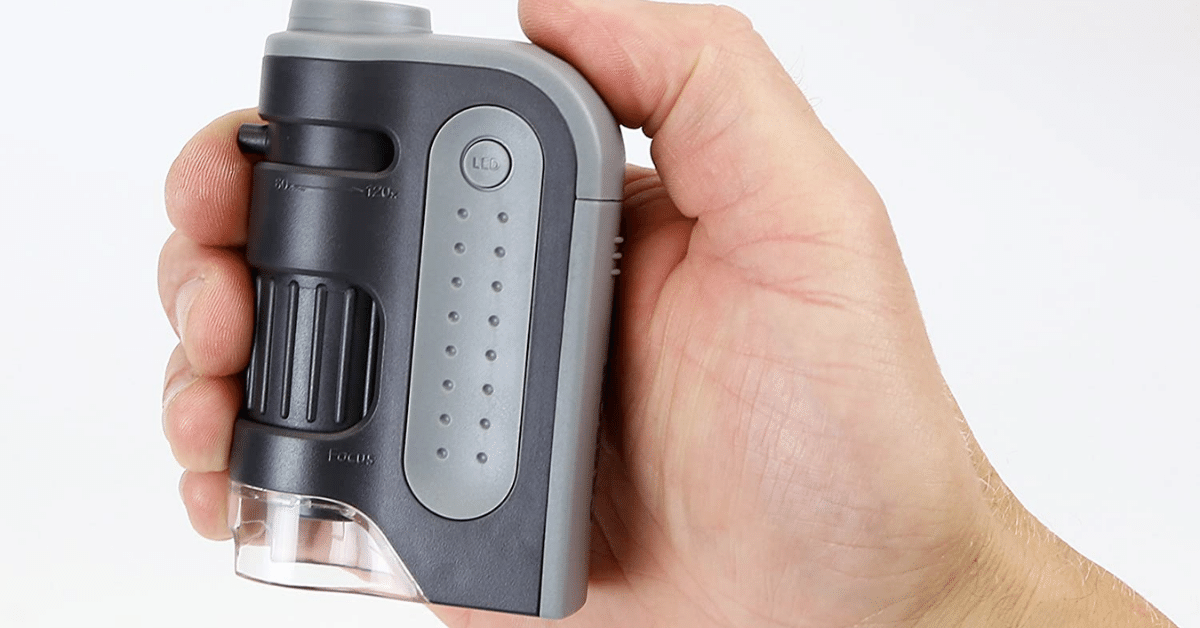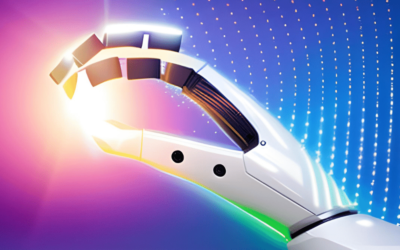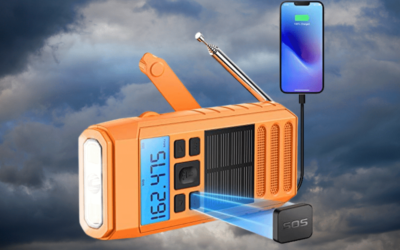Have you ever wanted to see the world in a miniature size? Look no further because the best pocket microscope has arrived! With the use of this microscope, you can see and explore the world like never before! So get ready to be amazed and explore with me as I give you a glimpse into this fascinating tool.
Top 7 Pocket Microscopes Right Now in 2025
- Pocket Microscope – The MicroBrite Plus LED Pocket Microscope is compact and lightweight, making it the perfect educational toy for portable use as a field microscope or classrom lab microscope.
- 1000X Magnification: BEBANG microscope has 200x-1000x 5-level zoom range, allowing you to explore a wide range of specimens, from small insects and plants to everyday objects like coins and fabrics.
- STEM Learning Experience – The Carson Pocket Micro is a great tool for promoting STEM education, encouraging children to explore the world around them, fostering a love for science and discovery.
- Powerful Mini Microscope – Conveniently sized to comfortably fit in a pocket or attach to a keychain, the MicroMini offers an impressive 20x magnification with UV lighting and built-in flashlight.
- 【Built-in Storage Space】WINWEND little scientist microscope is perfect for observing plants, insects, coins, jewelry, stamps, etc. It is also a great gift for children to stimulating their interest in the microscopic world. This digital microscope comes with bulit-in storage space, capable of storing 400 photos. Insert a personal storage card to shoot videos.
- Smartphone Digiscoping – The included smartphone digiscoping clip lets you document your findings, and allows children, students and educators to share their discoveries with ease.
- Portable Microscope for Kids:Microscope toys for little scientists, zoom 60x-180x, the set comes with 12 different plants and animals slides, by adjusting zoom and focus can observe a different micro world, our microscope is lightweight and portable, can be easily tucked into the pocket,your kid can observe the world at any time and anywhere with this little microscope, stimulate children’s interest in science.
About Pocket Microscopes
A pocket microscope is an invaluable tool for visualizing and magnifying small objects. It is highly portable, lightweight, and can often fit in the palm of your hand. Pocket microscopes are ideal for spotting insects, recognizing tread patterns, or studying minerals and plants up close while outdoors.
When shopping for a pocket scope there are a few key features to consider, such as magnification power and illumination type. The most common magnification range for these scopes is from 10x to 50x with some specialty models offering higher levels of magnification up to 200x. Standard illumination types include brightfield (light transmitted through the object) or darkfield (light reflected by the object). Brightfield illumination gives more detail but does not show organisms which have translucent bodies as darkfield does.
Some pocket microscopes even have additional features like built-in adjustable LED lighting or an adjustable focus knob that enables you to move closer to or away from the object of interest. Other unique features include manufacturers who combine traditional optics like stereo with digital imaging capabilities and cameras that enable you to share recorded images with others via WiFi or bluetooth connection.
Overall choosing the right microscope will depend on your intended use and budget. With a multitude of options available in today’s market ranging from basic models suitable for hobbyists to enriched models designed for professional use, it’s important to have a good understanding of all your options before making a purchase decision.
Benefits of Pocket Microscopes
Microscopes are essential pieces of laboratory equipment and many scientists, technicians, and students rely on them for their everyday work. Traditionally, microscopes have been bulky instruments that require several components to be setup correctly before use. However, technology has made it possible for microscopes to be offered in much more compact designs – pocket microscopes.
Pocket microscopes are smaller, more portable versions of laboratory microscopes. They offer many benefits compared to their lab counterparts, including mobility and convenience. Pocket microscopes often come with a variety of features such as LED lighting, multiple magnification settings, rechargeable battery packs or even built-in cameras that enable the user to record or share images directly from their microscope.
Due to their size and portability, pocket microscopes are ideal for a range of tasks; from observing a petri dish sample in the field to teaching elementary school children about science they allow exploration without the need for a lab environment. Unlike larger microscope models that involve several tools or accessories required for proper operation; pocket models come pre-assembled with all necessary components already in place – including LCD screens and buttons for easy operation – making them incredibly easy to use and operate with minimal effort from the user.
Whether you’re looking for an occasional hobbyist tool or full on professional instrument – pocket microscopes provide plenty of beneficial features and capabilities that can help make anything from routine research tasks to complex scientific applications far easier than ever before!
Types of Pocket Microscopes
Pocket microscopes provide a convenient way to explore the world of microscopic observations without purchasing a large and expensive laboratory microscope. These pocket-sized instruments are typically handheld devices that allow users to view cells, bacteria, or other samples while they are on an outdoor nature walk or doing science experiments in any location. While some design features will vary depending on the manufacturer, there are generally five distinct types of pocket microscopes.
1. Monocular Pocket Microscopes: Monocular pocket microscopes usually include a single shoulder-mounted eyepiece that can magnify objects hundreds of times their size while providing superior sharpness and contrast than lower quality magnifiers. As the most lightweight style of pocket microscope, they also tend to offer the most versatile uses and come with ultra-widefield eyepieces that help improve user comfort.
2. Binocular Pocket Microscopes: Offering advanced performance capabilities, binocular pocket microscopes consist of two oculars connected side by side by an eye-splitting prism located in the center field lens housing apparatus. This type is ideal for rapid viewing due to its greater comfort level and ability to see both sample images simultaneously at higher magnification levels than monocular viewing systems.
3. Digital Pocket Microscopes: One type of modern digital microscope technology can be found in high-end digital microscopes known as image processing analysis systems which provide a wide range of features like LED illumination options and extreme accuracy for capturing detailed images for scientific purposes and basic experiments alike.
4. X Zoom Pocket Microscopy Systems: For onsite applications, X zoom pocket microscopy systems feature powerful optics from 5X up to 1000X zoom magnification powers allowing users to view live data directly from the sample through any mobile device or tablet computing system featuring Wi-Fi connectivity options for easy data streaming and manipulation capabilities for research purposes or creative art projects related to scientific exploration materials like images taken right out of thin air!
5. Telescope Pocket Microscopes: More powerful than regular monoculars but often neglected in comparison with larger astronomical telescopes, telescope pocket microscopes deliver high resolution imaging with great contrasts under low lighting conditions but lack optical adjustments commonly found in dedicated astronomy models such as collimation synchronization settings between lenses coating layers thereby eliminating light scattering phenomena present during observations done through regular monoculars providing maximum transparency between front element plane glass surfaces!
How to Choose the Best Pocket Microscope
Pocket microscopes offer a lot of versatility when it comes to examining tiny objects. They come in a wide variety of sizes, magnifications and features, and can be used for many different types of investigation. To make sure you get the best microscope for your needs, it’s important to consider some key factors.
Magnification: Having a good magnification range is essential for probing microscopic details. Keep in mind that higher magnifications require additional optical clarity, so lens quality and robust construction should also be factored in when choosing the right pocket microscope.
Lighting: Illumination is an important factor when looking at small objects. Bright LED lights are perfect if you need to view objects outdoors or if you need maximum illumination levels indoors. On the other hand, softer LED lights may be suitable for more detailed work indoors or with live specimens such as insects or plants. Fluorescent light sources also provide good illumination options without being too harsh.
Battery life: How long your pocket microscope can run on battery power is important if you plan to do extended field research away from any power supply source . Make sure that the manufacturer lists battery life on all models so that you know what kind of time frame you have with each unit. Rechargeable batteries are convenient but may compromise usage time during long sessions outside of lab settings . Lastly, some models come with USB capabilities for powering up through computers and other external power supplies .
Sturdiness: Since pocket microscopes are often intended for use outdoors or in challenging environments , it’s wise to invest in a model which offers some degree of sturdiness . Options like dust-proof construction , adjustable stands , water resistance , shock protection and easy portability will help ensure reliable performance under demanding conditions . In addition , protected cases provide extra reliability while in transit between locations . Choose an option which offers the most protection against such potential hazards as exposure to moisture , dirt and temperature extremes .
Durability: Pocket microscopes must be designed not only to perform well but also to withstand the rigors of daily use over time . Good design principles will include quality parts built for lasting performance—such as brass geared focus mechanisms and durable finish coatings—to name just two examples . When selecting your model check out its overall reputation — both from user reviews and from trusted sources such as consumer magazines — and look into manufacturer warranties or service agreement terms that provide extra assurance against faulty units out-of-the-box or premature wear through normal use within an expected amount of time-duration ( 2 – 3 years typical)
Features to Look for in a Pocket Microscope
A pocket microscope is an essential tool for anyone interested in exploring the wonderful world of microscopy. The best pocket microscopes come with a variety of different features to ensure a quality viewing experience, so it pays to do your research before making a purchase. Here are some features you should look for when selecting a pocket microscope:
Magnification: It goes without saying that pocket microscopes should be able to provide you with a quality image. Look closely at the product specifications and find out what type of magnification the microscope offers – 15x, 20x or 25x? What’s the maximum resolution achievable? Can you increase or decrease the magnification power while viewing? Make sure to take all these questions into account before making your final decision.
Lighting: Good lighting is key when using a pocket microscope and many models come with powerful LEDs and two switchable light sources – one for dark-field illumination and one for bright-field illumination. Check how much control you have over the lighting – can you adjust its brightness or change its color temperature? Also, make sure the device offers switches for turning each of its light sources on/off independently.
Optical Components: Quality optical components are essential in getting clear images from your pocket microscope. Check carefully which lens types are used in building this device and make sure they all offer great resolution, contrast and clarity along with minimal distortion across their entire field of view range. Also, look if there are elements present that could reduce glare or image noise when using high magnifications like filters or anti-reflective coatings on optical surfaces contained within the lens system.
For measuring features, confirm any measurements offered by your pocket microscope can be calibrated correctly and accurately transferred over digital images through software applications included in its package so they can be used later on in studies or other projects..
Tips for Using a Pocket Microscope
Using a pocket microscope can give you a newfound appreciation for the incredible details found in your everyday surroundings – whether it’s looking at a single strand of your hair, examining the leaves of a plant or magnifying the texture of cloth. Setting up and using one is not particularly difficult and with the right tips and tricks you’ll be able to get up close and personal with all these tiny treasures!
When preparing to use your pocket microscope, it’s important that you have some basic knowledge about how the microscope works. Familiarize yourself with the parts of the device as each component serves an individual purpose. Every pocket microscope should contain an eyepiece which is used to view magnified images, an objective lens where objects are placed for magnification, and a focus knob which allows for adjustments in clarity.
Keep in mind that gentle adjustments will yield better results than excessive tugging on the focus knob; twisting too forcefully can break internal parts. Assemble your device accordingly following the instructions found on its packaging – make sure all pieces are secure before use! Additionally, never look directly into an eyepiece as doing so can cause potential damage to your eyesight.
Finally when using a pocket microscope, attempt to place objects on an illuminated background or surface as this will help generate clearer images within larger fields of view – doing so will make features easier to analyze without losing detail! Turn off any lights which could be causing too much glare during observation; less ambient light often leads to a sharper image quality when viewing microscopic textures or items at greater magnification levels.
Conclusion
In conclusion, finding the best pocket microscope depends on where it will be used and the purpose. A pocket microscope can be a great addition to your toolkit and can help you identify and analyze small objects that normally require monitoring by a lab technician or specialist. Investing in a quality pocket microscope with features that meet your needs is the first step towards getting reliable results in any environment.
Weighing each individual factor is key when selecting the right pocket microscope for your needs. While understanding, magnification range, illumination type, digital capabilities and portability are important considerations when purchasing one, also make sure to consider other factors such as ergonomics and cost before committing to an invest in such a device. Keeping all of these considerations in mind can help you narrow down your search for the perfect pocket microscope for you and ensure you get the most out of your purchase.










